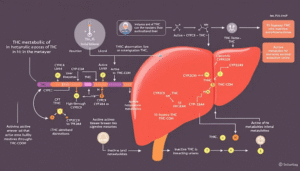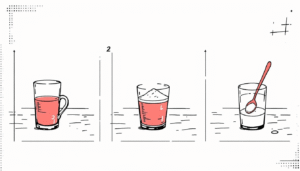How long does weed stay in system after quitting? Typically, it ranges from a few days to several weeks. The exact duration depends on factors like your usage frequency, body fat percentage, and metabolism. This article will explain these factors, different drug test detection windows, and tips for faster detoxification.
Key Takeaways
- THC retention in the body is influenced by factors such as frequency of use, body fat percentage, and metabolism speed, with chronic users potentially retaining THC for over 30 days.
- The type of drug test utilized significantly affects detection windows for THC, with urine tests typically having a detection period of 3 to 30 days, while hair follicle tests can detect THC for up to 90 days.
- Hydration, diet, and regular exercise play crucial roles in THC elimination, as they enhance liver function and metabolic rates, thus facilitating quicker detoxification processes.
Factors Influencing THC Retention
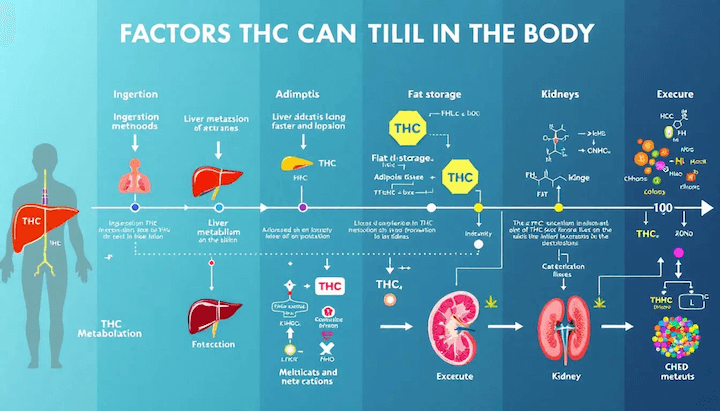
Several factors and other factors influence how long THC remains detectable in your system, ranging from individual physiological differences to patterns of marijuana use, including personal factors. Knowing these factors helps anyone aiming to effectively eliminate THC from their body.
The frequency of use, body fat percentage, and metabolism speed play significant roles in THC retention. These factors can determine whether THC metabolites stay in your system for a few days or several weeks.
Frequency of Use
The frequency of marijuana use is a primary determinant of how long does weed stay in your system. Habitual users, or chronic users, can retain THC metabolites for up to 30 days or longer due to the accumulation of these substances in their system. In contrast, occasional users might clear THC from their bodies within about ten days.
For heavy users, the detection period can extend to a significant period, sometimes even up to 60 days, reflecting the cumulative effect of repeated how much cannabis use.
Body Fat Percentage
Body fat percentage significantly affects THC retention:
- THC metabolites accumulate in fat tissues.
- Individuals with higher body fat percentages are likely to retain THC for extended durations.
- Conversely, those with lower body fat may clear THC more quickly.
THC is lipophilic, binding to fat molecules and being stored in fatty tissues.
Metabolism Speed
The speed at which your metabolism functions can significantly impact how long THC remains in your system. Individuals with faster metabolisms will clear THC more quickly, while those with slower metabolisms may retain THC for a longer duration.
Age, general wellness, and metabolic rate all influence how quickly THC is processed out of the body.
Types of Drug Tests and Detection Windows
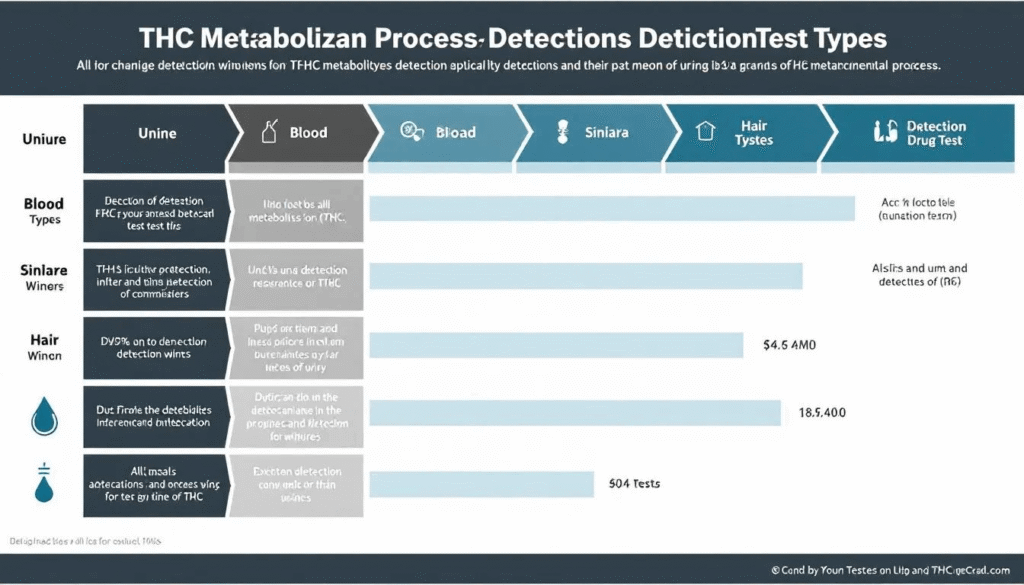
Drug tests are designed to detect THC metabolites in your system, and the type of test used can significantly impact the detection window. The most common types of drug tests include:
- Urine tests
- Blood tests
- Saliva tests
- Hair follicle tests
Each method has its own detection window, ranging from a few hours to several months.
Being aware of these differences helps anyone needing to navigate drug testing for marijuana detection.
Urine Tests
Urine tests are the most frequently used method for detecting marijuana use due to their ease and cost-effectiveness. The detection window for THC in urine can range from 3 to 30 days, depending on the frequency of use. Infrequent users typically clear THC within about ten days, while regular users may retain THC metabolites for several weeks.
Heavy users might test positive for up to 60 days due to extended THC retention in the body.
Blood Tests
Blood tests can detect THC for a shorter period compared to urine tests. Typically, THC is detectable in blood for about one to two days post-consumption. However, for chronic heavy users, the detection time can extend up to 25 days.
The method of consumption and the quantity of marijuana consumed can also influence the detection window in blood tests.
Saliva Tests
Saliva tests are less invasive and can detect THC from 24 to 72 hours after use. For occasional users, THC can be detected in saliva for up to 24 hours, while frequent users might have detectable levels for up to 72 hours.
Saliva tests are often chosen for their convenience and quick results.
Hair Follicle Tests
Hair follicle tests can detect THC for the longest period, up to 90 days after use. This method is particularly effective for identifying daily or near-daily hair follicles marijuana users.
Light users have about a 39% chance of testing positive, making hair follicle tests reliable for long-term detection.
Impact of Consumption Methods on THC Retention
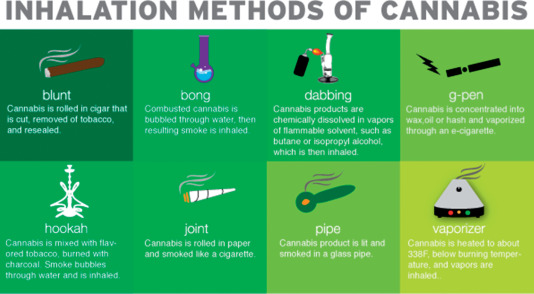
The method of cannabis consumption significantly impacts how long THC remains in the body. Inhaled methods, such as smoking or vaping, typically result in shorter THC retention times. In contrast, ingesting cannabis, such as through edibles, can lead to significantly prolonged retention of THC.
Different metabolism and absorption rates between these methods influence how long THC metabolites stay in your system.
Smoking or Vaping
Smoking or vaping marijuana generally results in a quicker clearance of THC from the body. Inhaled smoking marijuana leads to rapid THC entry into the bloodstream, causing a quicker onset of effects but a shorter detection period.
This typically makes THC detectable for a shorter time compared to other methods.
Edibles
Consuming cannabis through edibles leads to a prolonged retention of THC in the body. This is because THC is absorbed more slowly through the digestive system, leading to prolonged effects and extended detection times.
Edibles take longer to metabolize, making THC detectable for a longer duration compared to inhaled methods.
Role of Hydration and Diet in THC Elimination
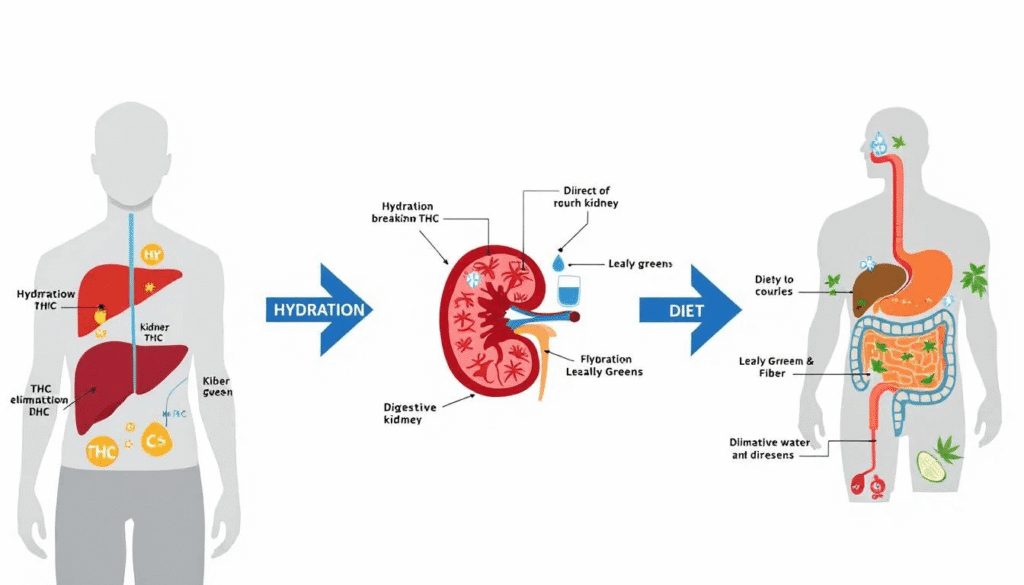
Hydration and diet play crucial roles in the elimination of THC from the body. Drinking sufficient water helps to flush out THC metabolites through urine, while a balanced diet supports optimal liver function, aiding in the detoxification process.
Eating fiber-rich foods and staying hydrated can significantly speed up how to eliminate thc faster.
Drinking Water
Staying hydrated is essential for flushing THC metabolites through urine. Drinking water increases urine production, which is crucial for eliminating THC breakdown products.
Although hydration alone may not ensure passing a drug test, it enhances the body’s ability to clear THC more effectively.
Healthy Diet
A balanced diet is vital for maintaining liver health, which is crucial for the detoxification process. A nutrient-rich diet supports the liver’s ability to break down THC into easily excreted metabolites.
Incorporating foods like leafy greens, garlic, and turmeric can enhance liver function and aid in the elimination of THC from the body.
Exercise and Physical Activity
Engaging in regular physical activity can effectively accelerate the elimination of THC from the body. Exercise boosts metabolism and promotes fat burning, both of which are essential for clearing THC metabolites stored in fatty tissues.
An active lifestyle not only supports overall health but also aids in quicker THC elimination.
Boosting Metabolism
Regular exercise significantly enhances metabolic rates, leading to faster THC removal from the system. Heart rate-boosting activities promote cardiovascular health and temporarily increase metabolic rate, facilitating quicker THC clearance.
An active lifestyle benefits both general health and THC detoxification.
Fat Burning
Exercise plays a crucial role in burning fat, which helps reduce the amount of THC accumulated in the body’s fatty tissues. Regular physical activity makes the body use fat stores for energy, releasing THC stored in fat.
Activities that promote fat burning can significantly aid in clearing THC from the system by both reducing fat stores and increasing metabolic activity.
Importance of Liver Function in THC Metabolism
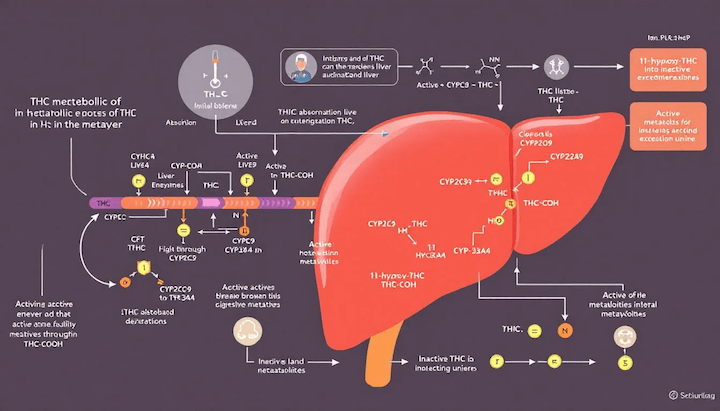
The liver is instrumental in metabolizing and eliminating THC, a psychoactive compound, from the body. THC is processed in the liver, where it is broken down into metabolites before being excreted.
Good liver health through a nutrient-rich diet and avoiding harmful substances is vital for effective THC detoxification.
Detoxification Process
During detoxification, the liver converts THC into water-soluble metabolites that are more easily excreted from the body. The primary route of elimination for these metabolites is through feces, with approximately 65% of THC metabolites being excreted this way.
Efficient liver function is crucial for detoxification.
Liver Health Tips
Maintaining good liver health through a nutrient-rich diet is essential for improving the detoxification of THC. Incorporating foods like garlic, turmeric, and leafy greens can support liver health and enhance detoxification processes.
A diet rich in antioxidants can support the liver’s ability to process and eliminate THC.
Potential for False Positives in Drug Tests
False positives in drug tests can occur due to various factors, including the consumption of certain foods and medications. It’s important to be aware of these potential pitfalls to avoid unwarranted consequences.
Understanding what substances can lead to false positives and ensuring confirmatory urine testing is crucial for accurate drug test results.
Medications and Supplements
Medications like Efavirenz and proton pump inhibitors can cause false positives for THC in drug tests. While NSAIDs and foods containing hemp are typically not responsible for false positives, it’s essential to be mindful of the potential interactions between medications and drug tests.
Confirmatory Testing
Confirmatory testing methods, such as gas chromatography-mass spectrometry, are crucial for distinguishing between legitimate drug use and false positives. These tests ensure accuracy by validating initial positive test results, reducing the likelihood of false positives, and ensuring fair outcomes. In some cases, individuals have tested positive for substances they did not use.
Secondhand Marijuana Smoke and Drug Tests
While it is unlikely for secondhand marijuana smoke to lead to a positive drug test, prolonged exposure in unventilated areas may increase the risk. Understanding the potential exposure risks and taking preventive measures can help mitigate the chances of testing positive due to secondhand smoke.
Exposure Risks
Secondhand marijuana smoke can lead to detectable THC levels, particularly if exposure is excessive and sustained in poorly ventilated areas. Although it is uncommon for secondhand smoke to cause a positive drug test, the risk increases with prolonged contact.
Hair tests are more susceptible to false positives from secondhand smoke, making it essential to be cautious about your environment if a hair test for drug testing is a concern.
Preventive Measures
To minimize the risk of exposure to secondhand marijuana smoke, consider:
- Using air purifiers
- Improving ventilation in areas where marijuana is smoked
- Avoiding spaces where marijuana is being consumed to significantly lower the risk of passive exposure.
These preventive measures are essential for anyone concerned about the potential impact of secondhand smoke on drug test results.
Understanding Marijuana Use Disorder
Marijuana use disorder, affecting about 30% of frequent users, can lead to dependence and addiction, which is a form of substance abuse. This disorder is characterized by an inability to stop using marijuana despite negative consequences.
Recognizing the signs of weed addiction and knowing available treatment options is vital for those struggling with chronic marijuana use.
Signs of Addiction
Signs of marijuana addiction include:
- Increased tolerance
- Withdrawal symptoms
- Cravings for marijuana
- Spending excessive time obtaining, using, or recovering from its effects
- Continuing use despite social, interpersonal, or occupational problems.
Recognizing these signs is the first step toward seeking help and recovery.
Treatment Options
Treatment options for marijuana addiction vary depending on the severity of the disorder. Effective interventions include behavioral therapies, cognitive-behavioral strategies, and motivational enhancement therapy.
These approaches help individuals manage withdrawal symptoms, reduce cravings, and develop healthier coping mechanisms.
Professional Help and Detox Programs for Marijuana Addiction
Seeking professional help is crucial for overcoming marijuana addiction. Detox programs, whether inpatient or outpatient, provide the necessary support and structured environment to manage withdrawal symptoms and prevent relapse.
Knowing the available options and choosing the right program improves the chances of successful recovery.
Inpatient Programs
Inpatient rehab programs offer a structured environment for individuals seeking to overcome marijuana addiction. These programs include counseling, medical supervision, and support groups, leading to higher success rates in achieving sobriety.
Comprehensive support in inpatient programs is crucial for long-term recovery.
Outpatient Programs
Outpatient treatment allows individuals to engage in recovery while maintaining their daily responsibilities. These programs offer flexible scheduling, accommodating those with less severe addiction or external commitments.
Participants benefit from therapies similar to inpatient settings, focusing on addiction coping strategies.
Summary
Understanding how long THC stays in your system and the factors influencing its retention is crucial for anyone quitting marijuana. By considering the frequency of use, body fat percentage, metabolism speed, consumption methods, and lifestyle choices, you can better manage the detoxification process. Whether through hydration, diet, exercise, or seeking professional help, taking proactive steps can significantly aid in eliminating THC and supporting overall health.
Frequently Asked Questions
How long does THC stay detectable in urine?
THC can remain detectable in urine for 3 to 30 days, with heavy users potentially testing positive for up to 60 days. The duration varies based on frequency of use.
Can secondhand marijuana smoke cause a positive drug test?
Secondhand marijuana smoke can potentially lead to a positive drug test, especially with prolonged exposure in poorly ventilated areas. Thus, it is advisable to avoid such environments to mitigate any risk.
What are the signs of marijuana addiction?
The signs of marijuana addiction include increased tolerance, withdrawal symptoms, intense cravings, and persistent use despite experiencing negative consequences. Recognizing these signs is crucial for addressing potential addiction.
How can I speed up the elimination of THC from my body?
To expedite the elimination of THC from your body, focus on staying hydrated, maintaining a balanced diet, engaging in regular physical activity, and supporting liver health. These practices can effectively enhance the detoxification process.
What professional help is available for marijuana addiction?
To address marijuana addiction, one can access inpatient and outpatient rehabilitation programs, behavioral therapies, and support groups such as Marijuana Anonymous, all of which are effective avenues for recovery. Engaging in these resources can significantly enhance the likelihood of overcoming addiction.

